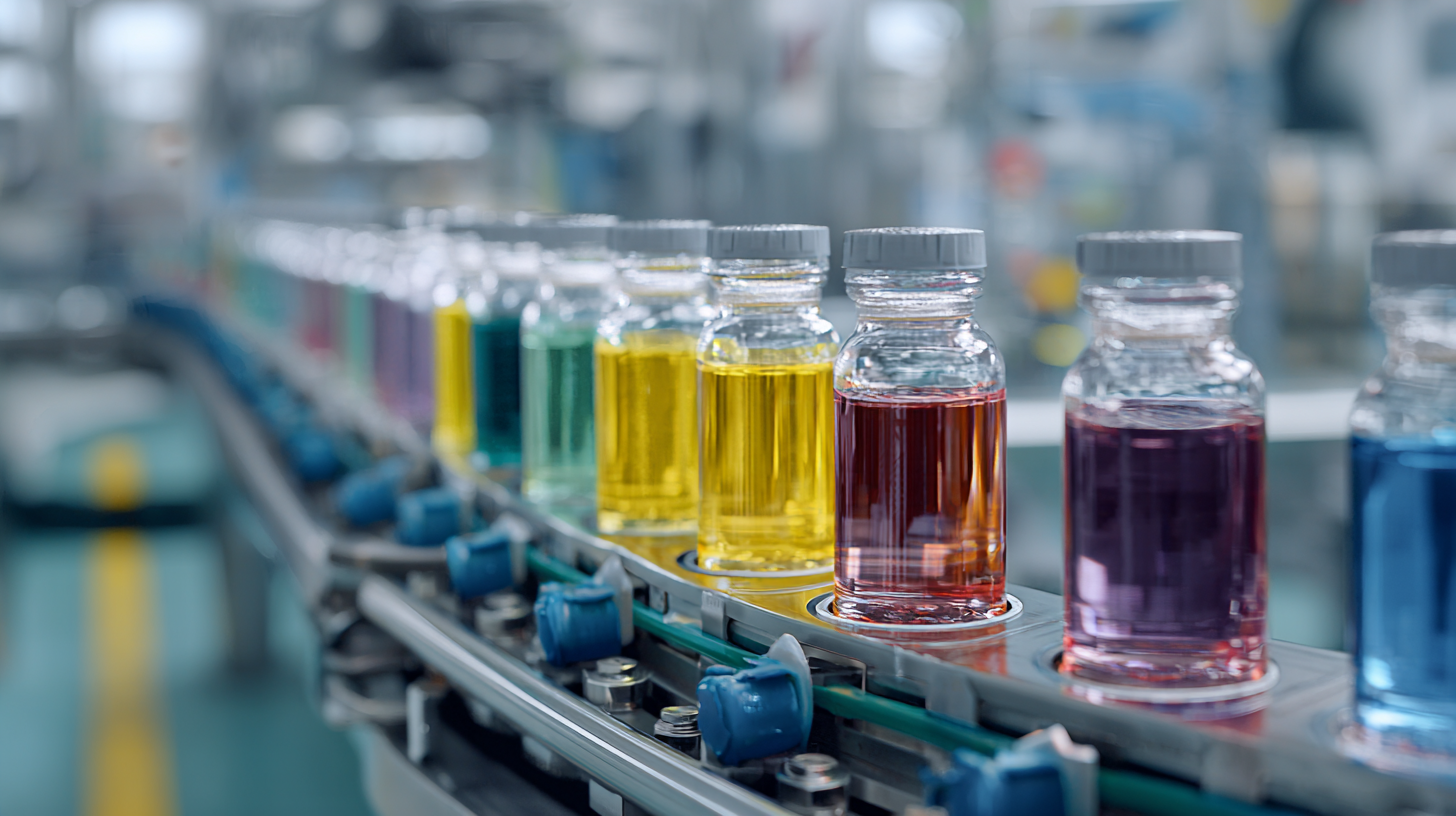How to Choose the Right Demulsifying Agent for General Purpose Applications
Table of Contents
- Understanding Demulsification: Key Concepts and Importance
- Types of Demulsifying Agents: Pros and Cons
- Factors to Consider When Choosing a Demulsifying Agent
- Application-Specific Considerations in Demulsification
- Testing and Evaluating Demulsifying Agent Performance
- Best Practices for Implementing Demulsifying Agents in Processes
- FAQS
- Conclusion
- Related Posts
 In the ever-evolving landscape of specialty chemicals, the selection of an appropriate Demulsifying Agent for general purpose applications is critical for maximizing efficiency and effectiveness in various industries. According to a recent market analysis, the global demulsifier market is projected to grow significantly, reaching over $2.5 billion by 2025, driven by the oil and gas industry's demand for effective separation solutions. At SHANGHAI QIXUAN CHEMTECH CO., LTD., we specialize in producing a range of specialty chemicals, including fatty amines, surfactants, and additives tailored for applications in sectors such as oil field, agro, and personal care. Understanding the diverse functions and formulations of Demulsifying Agents can greatly enhance operations in these fields, ensuring optimal performance and cost-effectiveness in processes that require the separation of emulsions. This guide aims to navigate the complexities of choosing the right Demulsifying Agent for general purpose applications, empowering companies to make informed decisions.
In the ever-evolving landscape of specialty chemicals, the selection of an appropriate Demulsifying Agent for general purpose applications is critical for maximizing efficiency and effectiveness in various industries. According to a recent market analysis, the global demulsifier market is projected to grow significantly, reaching over $2.5 billion by 2025, driven by the oil and gas industry's demand for effective separation solutions. At SHANGHAI QIXUAN CHEMTECH CO., LTD., we specialize in producing a range of specialty chemicals, including fatty amines, surfactants, and additives tailored for applications in sectors such as oil field, agro, and personal care. Understanding the diverse functions and formulations of Demulsifying Agents can greatly enhance operations in these fields, ensuring optimal performance and cost-effectiveness in processes that require the separation of emulsions. This guide aims to navigate the complexities of choosing the right Demulsifying Agent for general purpose applications, empowering companies to make informed decisions.
Understanding Demulsification: Key Concepts and Importance
Demulsification is a critical process in various industries, particularly in oil and gas, where the separation of water from crude oil is essential for improving product quality and system efficiency. Understanding the fundamental concepts of demulsification can greatly enhance your ability to select the right demulsifying agent for your specific needs. At its core, demulsification involves breaking the emulsion—essentially a mixture where tiny droplets of one liquid are dispersed throughout another—into its separate phases. This process is influenced by factors such as temperature, the nature of the emulsifying agents, and the chemical composition of the liquids involved.
The importance of effective demulsification cannot be overstated. Poor separation can lead to increased operational costs, reduced efficiency, and environmental issues due to improper disposal of emulsified waste. A well-chosen demulsifying agent can significantly speed up the separation process, improve recovery rates, and enhance the overall quality of the final product. By investing time in understanding the various types of demulsifying agents available and their mechanisms of action, industry professionals can ensure that they are making informed choices that will benefit their operations in the long run.
Types of Demulsifying Agents: Pros and Cons
When selecting a demulsifying agent for general purpose applications, understanding the types and their respective pros and cons is crucial. Demulsifiers can be broadly categorized into non-ionic, anionic, and cationic agents. Non-ionic agents are favored for their versatility and lower environmental impact, often used in oil-water separations across various industries. According to a report by Grand View Research, the global demulsifiers market is anticipated to reach USD 3.84 billion by 2025, indicating a steady demand for effective non-ionic options due to their effectiveness in a wide range of pH levels and temperatures.

On the other hand, anionic demulsifiers are particularly effective in emulsions with low pH levels, often utilized in petrochemical refining processes. However, they can be less efficient in high salinity environments, which is a significant drawback when considering their applications in the oilfield sector. Cationic agents, while highly effective in breaking emulsions in certain environments, tend to be less eco-friendly. A study from the Journal of Hazardous Materials highlights that the environmental toxicity associated with cationic agents can be detrimental, necessitating careful evaluation of safety practices in their application. Understanding these nuances can help in making an informed choice that aligns with both efficacy and environmental considerations.
Factors to Consider When Choosing a Demulsifying Agent
When selecting the right demulsifying agent for general purpose applications, there are several critical factors to take into account to ensure optimal performance. Firstly, understanding the nature of the emulsion is crucial. Identify whether the emulsion is Oil-in-Water (O/W) or Water-in-Oil (W/O), as this will guide you in choosing a demulsifier that is compatible with the specific emulsification process. For example, cationic surfactants tend to be more effective for O/W emulsions, while nonionic surfactants are versatile and can often work well in both types of emulsions.
Another important factor is the chemical composition of the demulsifying agent. At SHANGHAI QIXUAN CHEMTECH CO., LTD., we produce a variety of specialty chemicals, including fatty amines and amine derivatives that serve effectively as demulsifiers across multiple industries. Such agents should have the ability to properly interact with the emulsion components, breaking the bonds that hold the water and oil together.
**Tip #1:** Always consider the operational environment and temperature ranges of your application, as some demulsifiers perform better under specific conditions.
**Tip #2:** Conduct small-scale testing to evaluate the performance of the chosen demulsifying agent, ensuring that it meets your expectations before full-scale application. This will save both time and cost in the long run.
Demulsifying Agent Selection Factors
Application-Specific Considerations in Demulsification
Choosing the right demulsifying agent for general purpose applications requires a deep understanding of specific application needs. Demulsifiers play a crucial role in breaking the emulsions that can impede processes in various industries, such as oil and gas, agrochemicals, and more. When selecting a demulsifier, one must consider factors like the nature of the emulsion, the presence of contaminants, and operational conditions. Different formulations, including cationic and nonionic surfactants, may yield varying results depending on the application context.
At SHANGHAI QIXUAN CHEMTECH CO., LTD., our specialty chemicals, including fatty amines and amine derivatives, are tailored for such diverse applications. Whether it be enhancing separation efficiency in oil fields or improving processing in cleaning and personal care products, selecting the right agent means understanding the unique characteristics of the emulsion in question. Focusing on application-specific criteria not only ensures optimal performance but also aids in reducing costs and improving overall process efficiency.
Testing and Evaluating Demulsifying Agent Performance
When choosing a demulsifying agent for general purpose applications, key performance parameters must be rigorously tested and evaluated. Recent studies have underscored the importance of examining the demulsification performance of various agents under different operating conditions. For instance, research on citrus-based green demulsifiers has demonstrated their effectiveness in treating oil-in-water emulsions. These findings highlight not only the environmental benefits of such agents but also their cost-effectiveness, making them an appealing choice for widespread industrial applications.
Additionally, the study of ionic liquids like Tetrabutylphosphonium bromide has revealed promising results in optimizing demulsification processes. Their unique chemical properties contribute to enhanced stability and functionality in separating water from crude oil emulsions. The ongoing exploration of biodegradable polymers, such as ethylcellulose with varying viscosities, further illustrates the diverse pathways for improving demulsification efficiency. By understanding the mechanisms and behaviors of different demulsifiers, industries can make informed decisions, greatly improving operational efficacy while maintaining a focus on sustainability.
How to Choose the Right Demulsifying Agent for General Purpose Applications - Testing and Evaluating Demulsifying Agent Performance
| Demulsifying Agent | Viscosity (cP) | Break Time (min) | Separation Efficiency (%) | pH Stability Range |
|---|---|---|---|---|
| Agent A | 50 | 5 | 90 | 6-8 |
| Agent B | 75 | 4 | 85 | 5-7 |
| Agent C | 60 | 6 | 92 | 7-9 |
| Agent D | 45 | 3 | 88 | 6-8 |
| Agent E | 70 | 5 | 91 | 5-7 |
Best Practices for Implementing Demulsifying Agents in Processes
When implementing demulsifying agents in processes, several best practices can enhance their efficacy. First, it is crucial to select a demulsifier that matches the specific type of emulsion encountered. For example, oil-in-water and water-in-oil emulsions require different demulsification strategies due to their distinct characteristics. Conducting a thorough analysis of the emulsion’s properties, such as viscosity, pH, and temperature, can help practitioners make informed decisions about the most suitable agent to employ.

Another key practice is the optimal dosage of the demulsifying agent. Under-dosing may lead to insufficient demulsification, while overdosing can result in increased costs and potential re-stabilization of the emulsion. It is advisable to carry out small-scale tests to determine the relative effectiveness of various dosages before full-scale implementation. Regular monitoring and adjustment of the dosage during operation is also essential, as factors such as feed composition and process conditions can evolve over time, impacting the performance of the demulsifying agent.
Adhering to these best practices not only maximizes the effectiveness of chemical treatments but also contributes to more efficient and cost-effective processing.
FAQS
: Key factors include the type of emulsion (Oil-in-Water or Water-in-Oil), the chemical composition of the demulsifying agent, the operational environment and temperature, and the results of small-scale testing.
Understanding whether the emulsion is O/W or W/O helps in selecting a compatible demulsifier that will effectively break the bonds between water and oil.
Cationic surfactants are typically more effective for Oil-in-Water emulsions, whereas nonionic surfactants can work well for both types of emulsions.
Performance can be evaluated through rigorous testing and analysis under various operating conditions, as well as small-scale tests to gauge effectiveness before full-scale application.
Optimal dosage is critical; under-dosing may lead to incomplete demulsification, while overdosing can increase costs and cause potential re-stabilization of the emulsion.
Best practices include selecting the appropriate demulsifier for the specific emulsion, determining optimal dosage through testing, and regularly monitoring and adjusting dosage based on changing process conditions.
Citrus-based green demulsifiers are effective in treating oil-in-water emulsions and offer environmental benefits along with cost-effectiveness.
Ionic liquids, such as Tetrabutylphosphonium bromide, enhance demulsification processes by providing unique chemical properties that improve stability and functionality.
Research into biodegradable polymers, like ethylcellulose, aims to discover diverse pathways to improve demulsification efficiency while focusing on sustainability.
Practitioners should analyze properties such as viscosity, pH, and temperature of the emulsion to make informed decisions regarding the appropriate demulsifier.
Conclusion
In selecting the right demulsifying agent for general purpose applications, it's essential to understand the underlying concepts of demulsification and its significance across various industries. Demulsifying agents serve to separate emulsified mixtures, particularly in fields like oil and gas, cleaning, and personal care, where efficient phase separation is crucial. Each type of demulsifying agent, whether cationic or nonionic, comes with its own advantages and disadvantages that must be weighed against the specific requirements of the application.
Factors such as the nature of the emulsion, the environment, and the desired end product play a critical role in the selection process. Additionally, testing and evaluating the performance of demulsifying agents ensure that the chosen solution effectively meets operational standards. Best practices for implementation can further enhance efficiency and effectiveness, ultimately facilitating smoother processes in diverse applications. At SHANGHAI QIXUAN CHEMTECH CO., LTD., we specialize in producing high-quality specialty chemicals, including effective demulsifying agents tailored for a range of general-purpose needs.
Related Posts
-

Understanding the Technical Specifications of the Best AntiStripping Agent and How to Use It Effectively
-

Evaluating Different Strategies to Best Improve Construction Conditions
-

Exploring the Unique Features and Applications of Best N-Tallow-1,3-Propylene Diamine in Global Markets
-

Top Strategies for Effective Surface Dressing: Enhance Durability and Aesthetics
-

Innovative Solutions for 63428-92-2 Industries Empowering Sustainable Growth
-

How to Identify Top Quality Suppliers for Best Oleyl Diamine Ethoxylate Products
Blog Tags:

